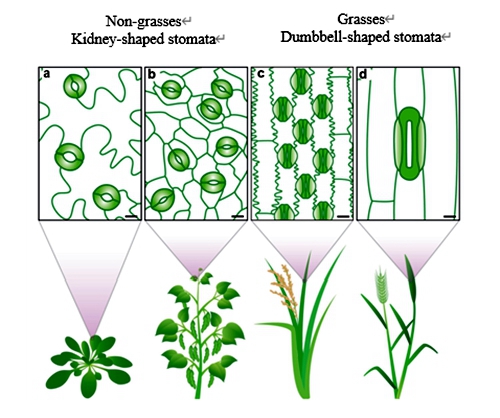Morphological Types Regulate Correlations between Stomata and Environmental Factors
Recently, the Agricultural Clean Watershed Innovation Team at the Institute of Environment and Sustainable Development in Agriculture, CAAS, identified the important role of morphological types of stomata in regulating the correlations between leaf traits and environmental factors. The team found that by distinguishing the differences between grasses and non-grasses in stomatal types, it is possible to change the response patterns of stomatal morphological traits to environmental factors, providing a basis for the consistency between plant traits and physiological consequences in studies across increasingly expansive scales. The related findings have been published in Nature Communications.

Grasses (e.g., corn, wheat, rice, etc.) have stomata with dumbbell-shaped guard cells, while non-grasses (e.g., soybeans) have stomata with kidney-shaped guard cells. The regulatory mechanisms of stomatal opening and closure differ significantly between the two types: (1) The unique morphology and mechanisms of dumbbell-shaped guard cells require only small changes in volume to bring about stomatal opening. As a result, stomata with dumbbell-shaped guard cells open and close much faster than those with kidney-shaped guard cells do; (2) The fully opened stomata of grasses are approximately the shape of a narrow rectangle, while the fully opened non-grass stomata are more of an oval. These characteristics of stomata with dumbbell-shaped guard cells allow grasses to exploit available light more efficiently and without losing unnecessary amounts of water and enhance the drought-tolerance of grasses.
Due to such differences between the two stomatal types in physiological consequences, the functional consequences of stomatal length will differ between grasses and non-grasses. In other words, stomatal length may not be a universal proxy trait of stomatal function when both types of stomata are included in a study. Therefore, in a study of the correlations between stomatal morphological traits and environmental factors, it is necessary to distinguish the differences in stomatal morphology across different plant groups, which can otherwise cover up the major differences in physiological consequences of plants. This study proposes that when exploring the correlations between morphological traits of different plants and the environment, two principles of consistency should be followed: firstly, morphological traits and physiological consequences should be consistent; secondly, the response patterns of a trait to a given environmental factor should be consistent across different plant groups.
This study was supported by the National Natural Science Foundation of China and the Key Laboratory of Agricultural and Rural Ecological Environment of the Ministry of Agriculture and Rural Affairs.
Linkage: https://www.nature.com/articles/s41467-025-61635-y
-
 Jul 09, 2025CAAS President meets with WUR Executive Board Member
Jul 09, 2025CAAS President meets with WUR Executive Board Member -
 Jul 09, 2025CAAS President Meets with AAS President
Jul 09, 2025CAAS President Meets with AAS President -
 Jul 09, 2025Secretary of the Leadership Party Group of CAAS Meets with Secretary of the Brazilian Ministry of Agriculture and Livestock
Jul 09, 2025Secretary of the Leadership Party Group of CAAS Meets with Secretary of the Brazilian Ministry of Agriculture and Livestock -
 Jul 09, 2025CAAS Deepens Scientific Cooperation with IAEA
Jul 09, 2025CAAS Deepens Scientific Cooperation with IAEA -
Jul 09, 2025CAAS Deepens Agricultural Science and Technology Cooperation with Eastern European Countries
